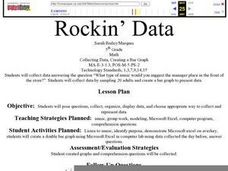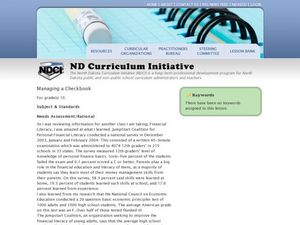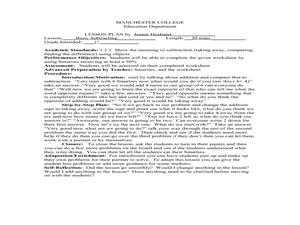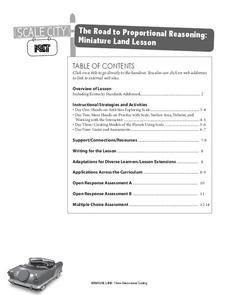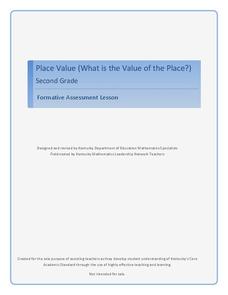Curated OER
Rockin' Data
Fifth graders are given the questions, "What type of music would you suggest the manager place in front of the store?". Students collect data by talking with 20 adults and create a bar graph on the computer to present the data.
Curated OER
Graphs: All About Our Class
Students respond to survey questions, discuss results, brainstorm ways to represent survey information, and create table of class results. They find mean, range, and percentages, and create graph to display results.
Curated OER
Everybody Is a Winner in the Iditarod
Students read an article about the Iditarod winners. Using the document, they answer questions on a worksheet and examine the history of the race as well. They complete an activity using the internet to end the activity.
Organization for Educational Technology & Curriculum
Introduction to Variables and Algebraic Expressions
Begin your next algebra unit with this introductory lesson on variables and algebraic expressions. This plan requires a SMART board and includes a SMART notebook file. The file contains a guiding question and two learning activities that...
Curated OER
Managing a Checkbook
How do grown ups do it? Teach your upper graders the ins and outs of personal finance by having them use their algebra skills to balance a checkbook. They examine the financial side of math, set up a checking account, and balance their...
Curated OER
Mean and Standard Deviation
Get two activities with one activity. The first activity, is appropriate for grades 6-12 and takes about 20 minutes. It introduces the concept of measures of central tendency, primarily the mean, and discusses its uses as well as its...
Curated OER
Volume and Surface Area
Students explore volume and surface area. In this math activity, students fill boxes with cubes to identify the volume of the boxes. Students discuss area.
Illustrative Mathematics
Baseball Cards
Here is a resource that demonstrates growth and the initial state of an equation. In this case, your class will be looking at baseball collections. How many baseball cards did the collector start out with, and how many were added or...
Illustrative Mathematics
Factors and Common Factors
This is an exercise in finding the greatest common factor of two whole numbers. Use in direct instruction or as part of your guided practice. Make up additional problems for home work. It also can be used as a mini-assessment or test...
Curated OER
What's Playing Tonight?
Students collect data and visually represent it. They conduct a survey of favorite movies. Using a spreadsheet, students organize the data and create bar and circle graphs. Students answer statistical questions regarding the data.
Curated OER
Comprehension of Word Problems
Third graders explore math functions by completing a worksheet in class. In this word problem solving lesson, 3rd graders read a book titled Counting on Frank by Rod Clement and utilize the information in the story to answer study...
Curated OER
Basic Subtracting
First graders solve math problems. For this subtraction lesson, 1st graders use Smarties to compare addition and subtraction. Students complete math problems where they solve basic subtraction questions.
Curated OER
Acting Like a Hog
Learners explore game theory. In this secondary mathematics lesson, students plat the game of HOG using dice and explore the optimal strategies. Learners play the game three ways: any number of dice, a fixed number of...
Curated OER
Multiplication by 10
Learners practice their multiplication skills by playing a game. They play the online interactive game Powerama 5M where they multiply numbers by 10, 100, 1000 and 10 000. Afterward, they complete a paper based worksheet for assessment.
Virginia Department of Education
Spring Fling Carnival
Think critically — and linearly by applying linear equations to solve real-world problems. Young mathematicians write equations to model the profit on popcorn and cotton candy at a carnival and solve problems using these equations.
Illustrative Mathematics
Adding Tenths and Hundredths
Learning to add fractions with different denominators presents a big hurdle for many young mathematicians. Simplify the process for learners with this series of practice problems involving the friendly fractions tenths and hundredths....
Kentucky Educational Television
The Road to Proportional Reasoning
Just how big would it really be? Young mathematicians determine if different toys are proportional and if their scale is accurate. They solve problems relating scale along with volume and surface area using manipulatives. The...
Mathematics Assessment Project
Sampling and Estimating: Counting Trees
Your task today: count all the trees on a tree farm. To complete the assignment, learners first estimate the number of trees on a tree farm using random sampling. To improve their own response they then evaluate provided...
Curated OER
Place Value - What Is the Value of the Place?
Second graders build number sense in an activity that requires the matching of base 10 representations to numbers. It is the teachers responsibility to gauge student understanding and involvement while class members work in groups.
Mathematics Assessment Project
Sharing Costs Equitably: Traveling to School
Drive or take the school bus? Class members determine the amount each student would have to pay in a carpool situation. They then evaluate the cost in a set of provided examples. I think I'd rather take the school...
EngageNY
Determining Discrete Probability Distributions 1
Learn how to determine a probability distribution. In the ninth installment of a 21-part module, future mathematicians use theoretical probabilities to develop probability distributions for a random variable. They then use these...
Mathematics Assessment Project
Comparing Strategies for Proportion Problems
Having problems with proportions? Then solve these proportion problems with an exercise that asks learners to first individually solve a set of problems involving ratios and proportional reasoning. Groups then discuss provided...
American Statistical Association
Happy Birthday to . . . Two?
How many people do you need in a room before two likely share the same birthday? Scholars consider this puzzle by analyzing a set of data. They ponder how to divide the data and determine the proper size of a group for this event to...
Arizona Department of Education
Introduction to Integers
Welcome to the backward world of negative numbers. This introductory lesson teaches young mathematicians that negative numbers are simply the opposite of positive numbers as they use number lines to plot and compare...
